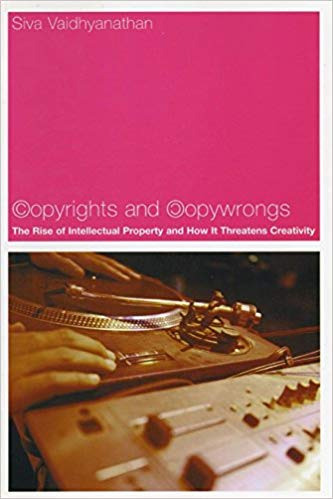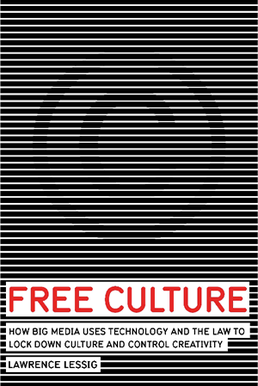I fought the law … (but I can’t complete this sentence because the RIAA would sue me if I did.)
This is a review of two books which are essential reading in understanding one side of an important debate in American culture—the issue of copyright in the age of the internet and digital media. The books are:
Copyrights and Copywrongs: The Rise of Intellectual Property and How It Threatens Creativity, by Siva Vaidhyanathan (New York University Press, 2001)
Free Culture: How Big Media Uses Technology and the Law to Lock Down Culture and Control Creativity, by Lawrence Lessig (The Penguin Press, 2004).
Let me begin with two reflections. The first is the summer of ’82 as I experienced it. I had just finished high school and was working for the summer as a ride operator at Canada’s Wonderland. I met a girl who worked at the park running games. We went out. I drove to work in my father’s Oldsmobile with the windows rolled down, blaring the radio. During that summer, there was a string of hits on the radio—John Cougar Mellencamp’s “Jack & Diane,” ABC’s “The Look of Love,” Roxy Music’s “Avalon,” Alan Parson’s “The Eye in the Sky” … Even now, when I hear those songs, I am transported back to the summer of ’82 when I had a great time with friends, enjoyed a summer romance, drove my parents crazy. That music has become embedded in my memory. It has become inextricably tied to my sense of who I am.
The second reflection is the summer of ’05, right now, watching as my children, now teenagers, have begun to lead lives just a little beyond my control, going to the Baskin Robbins on the corner to meet friends, going to movies, and, yes, going with friends to Canada’s Wonderland. They make their arrangements, not on the phone the way I did, but by texting. But like me, they draw powerful associations with music—“their” music. They listen to Red Hot Chili Peppers and Weezer and Coldplay and (which astonishes me) the Beatles. But they don’t listen to the radio. Instead, they listen to iTunes. And they email mp3 files to one another. Or email titles and then download them on Limewire or KDX. Or they burn them to CD’s or DVD’s and trade them or give them away.
Both reflections illustrate how one facet of our culture—music—creates strong associations which end up, through some organic process, becoming melded to our personal identity. This music is not “out there” as an object to be grasped for a time and then returned once we are done with it; this music is “our” music. And yet, as Lessig relates, the RIAA, representing American recording artists, has gone so far as to sue a 12 year old girl—she could be my daughter—for doing what any normal girl her age enjoys doing: playing “her” music. Both the RIAA and the 12 year old girl understand music as proprietary in some sense, but their understandings are wildly divergent. These divergent understandings of cultural “products” and the rights attached to such “products” is the subject under consideration by both Vaidhyanathan and Lessig. Both authors ask how the debate could have become so extreme in its polarization, how the stakes could have become so high (so that a 12 year old would have to surrender her savings of $2,000 in an out-of-court settlement) and what can be done to restore a sense of balance to the debate.

Vaidhyanathan makes it clear that he does not write about copyright from the lawyer’s perspective. Although he gives a highly readable and largely anecdotal account of the high points of American copyright law, his primary interest is as a social scientist. He wants to explore what culture means to us in its “written” forms and his concern for legal issues arises only to the extent that law impacts upon our evolving apprehension of those meanings. The greatest portion of his book is engaged in the task of deconstructing the notion of authorship. He sees today’s debate not as the consequence of opposed positions on the same issue, but as the consequence of the failure to recognize that different parties are talking about different issues. The powerful media lobbies hearken back to a notion of authorship which first arose in the Renaissance—a one-for-one correspondence between the creator and the created. The poem exists because the poet wrote the poem, and therefore, to the extent that the poem was the result of the poet’s effort, then the poet should be compensated for the use to which others put his poem.
This view was most acutely entrenched by the English Romantic poets. There is a natural alignment between English Romanticism and American individualism. They are cousins for whom Shakespeare is their grandfather. But there is another story of authorship deeply embedded in the story of American creativity—the Afro-American influence. Because blacks first came to America as slaves and because illiteracy was a deliberate part of their oppression, their earliest story-telling in America was oral histories. And alongside oral histories came varied forms of folk music whose descendants include gospel and the blues. It is notoriously difficult to trace authorship (in the traditional sense) for oral histories and folk music. As Muddy Waters said of his blues riffs, he got them “from the corn field.” And it is Afro-American culture which has, with the help of the internet, precipitated the current crisis of copyright law. The practices of borrowing and building upon the work of others, which are the foundations of hip hop, and scratch music and sampling, have attracted the full force of copyright law which takes no account of such “primitive” notions of authorship.
Vaidhyanathan’s book provides ample support for the contention that those who insist in the strict enforcement of copyright law for personal enrichment commit a grave cultural hubris. Authorship is always a collective effort and therefore the resulting property always belongs to everybody.

Lessig’s account concerns itself with more recent events, describing how big media interests have sought to entrench this cultural hubris as a hallmark of American copyright law. Like Vaidhyanathan, he argues passionately that a culture of permission (one in which I must ask permission to incorporate the work of others into my own creations) has a chilling effect upon creativity. For example, copyright law has always provided a fair use exception: there is a social utility in copying the work of others to encourage education, the free play of ideas central to democratic health, critical commentary, etc. But if even the threat of litigation will bankrupt an academic or a freelance journalist, then, in a litigious environment, it becomes safer to avoid the issue altogether. This, argues Lessig, is bad for the health of american academic institutions (resulting in what Allan Bloom has described as “The Closing of the American Mind”), it is bad for democratic institutions because it hampers open debate, and more generally, it is bad for American culture.
Indeed, since the publication of Free Culture, the Supreme Court has handed down the Grokster decision which renders the debate even more extreme and dangerous for those who wish to produce technologies which facilitate the dissemination of cultural works. The Supreme Court held that Grokster, the creator of a peer to peer file sharing protocol, was vicariously liable for copyright violations it facilitated through its technology even though it did not directly commit any copyright violations. As Lessig points out in the Sept/05 issue of Wired, Apple’s iPod is captured by the ruling and therefore should be illegal. But, since this whole issue is about money and power, it is unlikely that Apple will be affected (although it has eliminated the “Rip, Mix & Burn” tag from its advertising). Because this is about power and intimidation, it is not surprising that today the Wall Street Journal [link broken] reports that a blogger faces a lawsuit for comments posted by readers.
However, the bleak state of American culture is not solely the consequence of a poorly nurtured legal structure; it further suffers from an increasing concentration of control over cultural “product” in the hands of a few vertically integrated media behemoths. Clearly, in many industries, Americans have benefited enormously from economies of scale. Sometimes, bigger is better. But in the case of culture, there are values which cannot be quantified on any economic analysis. If, one day, a single company owns Penguin Books (which published Free Culture), my ISP and the host of my web domain, and if that company takes exception to my comments, then it will be in a position to take any number steps to censor my post while leaving me powerless to do anything about it. Freedom from censorship is a value which may well trump the degree of control demanded by big media.
Lessig proposes several measures to strike a reasonable balance between the need to compensate creativity (no artist should be a starving artist) and the need to promote the culture which is the breeding ground for all creativity in the first instance. He strikes this balance by limiting the duration of copyright to ensure that all works eventually pass into the public domain while those without commercial value pass more quickly. One of his proposals, the Creative Commons License, is a measure which any creative individual can adopt today. The Creative Commons License provides model licenses for many other jurisdictions.
The multi-jurisdictional nature of CC leads to the last issue: why should I, as a Canadian, care what two authors say about the state of copyright law in America?
First, American media conglomerates have powerful lobbies here in Canada and are trying to encourage an American-style prohibitionist copyright policy. Witness the efforts of Graham Henderson, entertainment lawyer and president of the CRIA (Canadian Recording Industry Association). To date, Canadian politicians and judges alike have followed the counsel of caution. (Vaidhyanathan describes at lengths Mark Twain’s efforts to promote more “modern” copyright laws and cites his anger at Canadians for their leniency which, in his view, made Canada fertile ground for pirates. Sound familiar?)
Second, Canadians need to celebrate the differences. Historically, on just about every policy front, we have tended towards a socialized approach while leaving ideology at the door. A view of wider social responsibility has affected everything from taxation to delivery of health care and education. And so it is not surprising that authorship and the sacrosanct position of individuality has less of a footing on Canadian soil. We do aim to reward authorship, but our political leaning towards social responsibility mitigates against a one-for-one correlation between units of product sold and royalties. And so we have chosen to address the issue of “piracy” by taxing recordable media and distributing the proceeds to artists (not unlike the model for dealing with photocopying in public libraries). Naturally, big media intimates that this is the notion of a technologically illiterate back water. Personally, I think it is best described as different. And difference alone is never cause for criticism. Our difference is predicated upon slight cultural tweakings that have gone unnoticed south of the border. Our difference reflects an alternative understanding of authorship, an alternative understanding of how authorship should be rewarded, and an alternative understanding of social and political responsibility generally.
To date, even the CRIA has kept from suing 12 year old girls. So we must be doing something right.